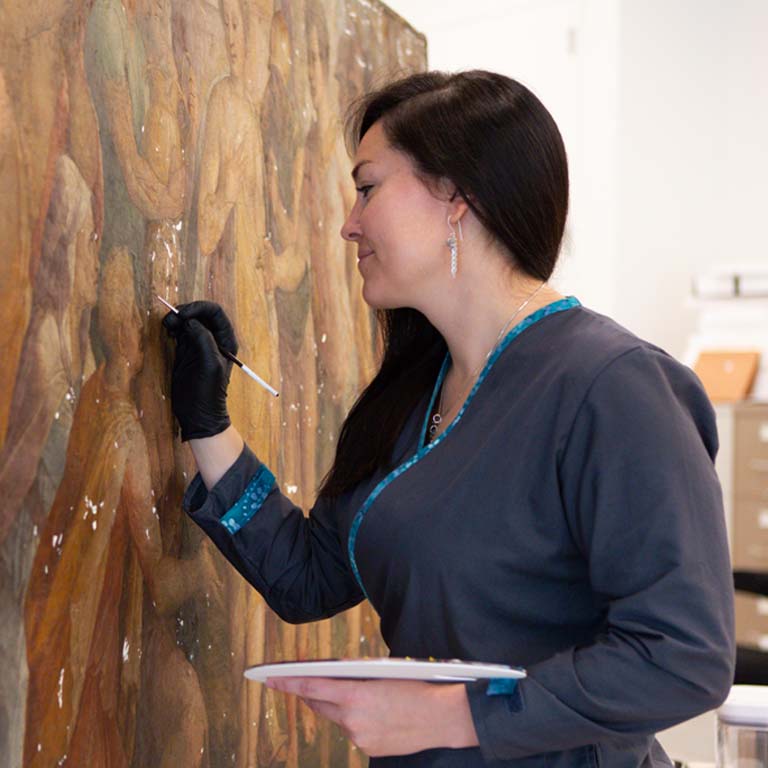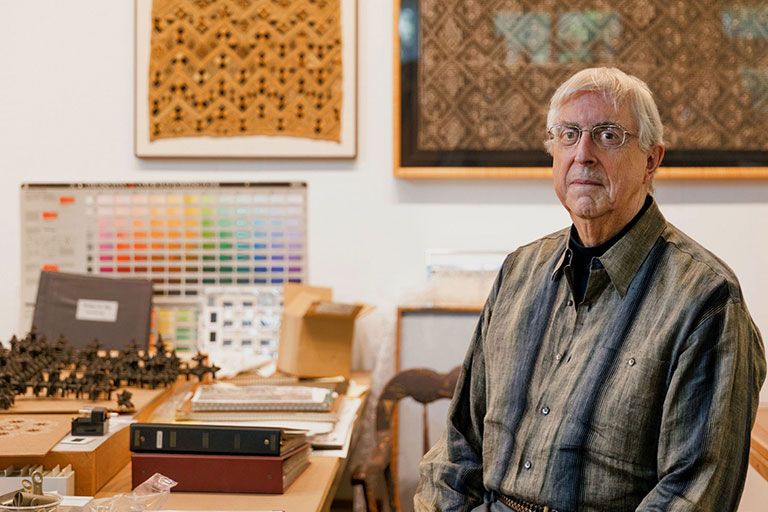Your support of the Sidney and Lois Eskenazi Museum of Art provides new opportunities for conceptual and critical thought. It allows us to continue to build, sustain, and display our growing collections. And it helps us instill a deep love for the arts in people everywhere. Thank you!
Your gift can make a difference
Questions?
Whether you’re an individual or represent a business, if you’d like to learn more about giving to the Eskenazi Museum of Art, please contact Director of Development Christine Baldwin.
Designating your gift
Keep reading for examples of and stories about the many ways you can give, such as supporting our art therapy and education programs or helping with exhibitions, acquisitions, or conservation.
How your gift can help
Art therapy
Our Center for Education is an essential element in fulfilling our mission to be a preeminent teaching museum. We offer experiences that inspire arts-based learning for diverse audiences. Your support of education at the museum helps us reach a vast array of learners through university, youth, public, tour and docent, and arts-based wellness experiences.
Description of the video:
Lauren Daugherty: Art therapy at its core is a mental health profession that promotes health and well-being in individuals of all ages with a variety of concerns.
[Words appear: Lauren Daugherty, Arts-Based Wellness Experiences Manager]
But it really is a lot more than that here at the Eskenazi Museum of Art—it’s a way for people to understand better the world around them and their relationships with others by immersing themselves in the creative process.
So here, our programming, we’re doing things in the galleries; we’re looking at and talking about art. And we’re also making art in our brand new art-making studio.
[Words appear: Heidi Davis-Soylu, Lucienne M. Glaubinger Direcgtor of Education]
Heidi Davis-Soylu: It’s actually quite unusual to have an art therapist on staff at a university art museum. There are a handful of art therapy programs at big city art museums. But the Eskenazi Museum of Art is really at the leading edge of the art therapy presence in university context.
Our art therapy program is going to make the museum more accessible to individuals with disabilities for example, or those with mental health concerns, or simply those wanting to grow and learn more about themselves and the world they live in.
As a teaching museum, we feel it is important to invite every audience possible to engage with our collection and to experience our art therapy program.
Lauren Daugherty: The way art therapists utilize art materials is a little bit different from traditional art educators. For example, individuals with anxiety, they often are most successful with materials that are more controllable. So things like collage, markers, and colored pencils. And folks that can handle art materials that offer a little bit more of an emotive response—they will use things such as pastels and watercolor.
There are art materials that fit individuals of all levels of functioning, and art therapists are specifically trained mental health professionals that know when to use those materials to support their clients and make them as successful as possible.
[Words appear: Sharon Wiseman, Lifelong Learning Student]
Sharon Wiseman: I was fortunate to take part in an Art Heals class that Lauren Daugherty gave for Lifelong Learning at IU and I learned some very interesting things.
First, what fun it was to be exposed to a lot of different art material—everything from clay to watercolor to pastels. And as an adult we just don’t have that much opportunity to play and to work with art materials.
Second, it was very interesting for me to learn how art and art materials could be used in therapy to help people lead better lives. And it gives me great hope that many people will have an opportunity to take advantage of this.
And third, it was very satisfying to be able to use color, line, art materials in a way to express emotions or something that was happening in my own life. And then to see it, there physically, or on paper. And I really hope that more people have an opportunity to experience art therapy.
Lauren Daugherty: Art therapy at the Eskenazi Museum of Art utilizes a unique approach—one that isn’t really present in the majority of art therapy programs. It places just as much emphasis on the meanings that art therapy clients find in works in our collection and the meaning they find in works they create themselves.
By offering this type of art therapy in a university art museum, we’re connecting students, staff, faculty, and members of the Bloomington community with wonderful works of art.
We’re exposing those same individuals to the healing power of the creative process and are promoting health and well-being campus and community wide.
The art therapy program allows the museum to further activate its wonderful collection and our art-making studio by encouraging deep, personal meaning-making and reflection, which then allows art therapy clients to really, you know, make a lasting connection with the museum, with specific works of art, and with art making processes that lead to healing.
Special exhibitions
When IU alumna Susan Thrasher joined a campus art tour during a visit in 2004, little did she know that she was beginning a long-standing relationship with art at IU. Susan’s desire to get art back into her life has led to support of the Eskenazi Museum of Art’s conservation fund, ongoing support of the Annual Fund, a position on the museum’s national advisory board, and an endowment supporting special exhibitions.

Special exhibitions are so important—critical—to the vibrancy of the museum.
Susan Thrasher, IU alumna and museum supporter
Acquisitions

A museum volunteer for more than ten years, Paula Sunderman was inspired to learn more about African art. After taking classes at IU, she decided to use a percentage of the required minimum distribution from her individual retirement acccount (IRA) to help the museum make strategic acquisitions. Her goal is to help acquire a work of art in every curatorial area.
Save on taxes
Do you have an IRA? Are you 70½ years old or older? Consider giving your required minimum distribution (up to $100,000) to the Eskenazi Museum of Art and pay no income taxes on the distribution. The transfer of the funds generates neither taxable income nor a tax deduction, so you benefit even if you do not itemize your deductions.
Conservation
Your support of conservation efforts at the museum ensures the proper physical care of artwork through documentation and ethical treatments. Conservators also advised on desirable environmental conditions, including lighting, temperature, relative humidity, presentation, loans, and general care. Our conservation tasks take place in the museum’s Center for Conservation.

Julie Ribits, the Beverly and Gayl W. Doster Paintings Conservator at the Eskenazi Museum of Art, focuses on the paintings in our collection. This includes researching artists’ materials and techniques; documenting damage to paintings as a result of inherent vice, environment, and human interaction; and treating paintings that are in need of intervention.
Collective giving

In 2015, Bloomington natives Donald Griffin Jr. and Nicole Griffin had an idea that has since turned into an ongoing initiative to increase the museum’s holdings of artworks by African American artists. Together they created a coalition of local leaders with the shared desire to help better represent black culture at the museum.
The group initially funded three new acquisitions of work, which immediately had an impact on visitors. During a tour for first-generation college students, one freshman who was captivated by Kerry James Marshall’s print Untitled (Handsome Young Man) said, “I’ve never seen anyone who looks like me in a museum before.”
By uniting a group of community members behind a common cause, the Griffins are harnessing the power of collective giving to make a real difference at IU and in the Bloomington community.
Give works of art
The museum received a transformative estate gift from painter, collector, and IU Professor Emeritus of Fine Arts William “Bill” Itter. The gift includes an exceptional collection of more than 500 objects such as African ceramics, textiles, and baskets. Itter and his late wife, Diane, a pioneering fiber artist whose work can be found in major museums across the United States and in Europe, began collecting in the 1970s. Attracted by the beauty of handmade ethnographic objects, the Itters were inspired to form an objects library that contributed to and reflected their studio and teaching disciplines.
The museum’s internationally recognized sub-Saharan African art collection is considered outstanding, and Itter’s gift greatly enhances these holdings. The gift also established the William and Diane Itter Museum of Art Conservation and Research Endowment, which will allow either the hire of an objects conservator or further research into the museum’s collections. The endowment portion of the gift was matched as part of the $3 billion For All: The Indiana University Bicentennial Campaign. A new objects viewing room, which will offer students opportunities for engaging directly with art, was also named in honor of Bill and Diane.
Give a gift of art
We’re always eager to talk with private donors and collectors about gifts of museum-quality paintings, works on paper, and objects. By giving a work of art, you ensure that it will be enjoyed by the public and receive the best care possible. Gifts of art are largely responsible for making the museum’s holdings among the finest university collections in the country.

The Indiana University Foundation solicits tax-deductible private contributions for the benefit of Indiana University and is registered to solicit charitable contributions in all states requiring registration.




